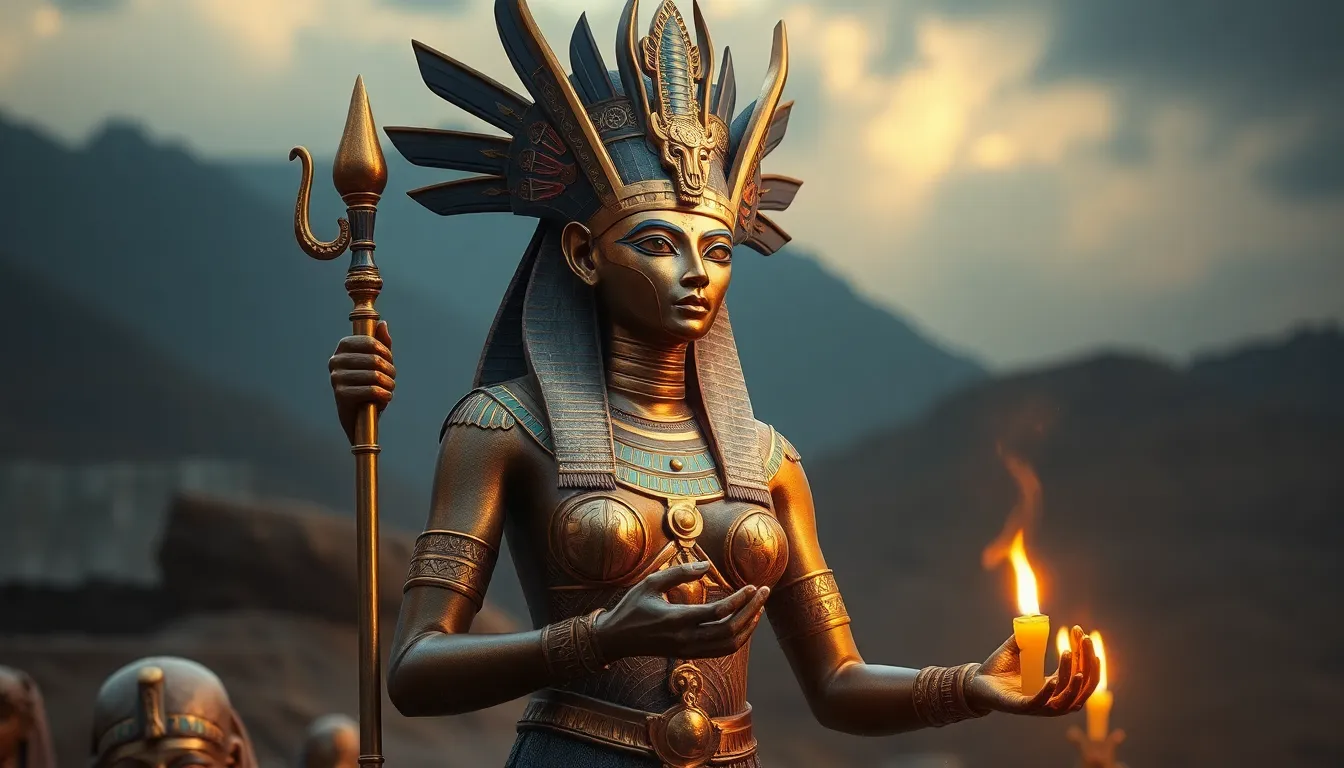The Role of the Goddess Sekhmet in Healing Rituals
I. Introduction
In the rich tapestry of ancient Egyptian mythology, one of the most formidable deities is Sekhmet, the lion-headed goddess. Sekhmet represents both destruction and healing, embodying the duality of life’s forces. In a culture that placed immense value on health and well-being, Sekhmet was revered not only as a warrior goddess but also as a powerful healer. This article aims to explore the multifaceted role of Sekhmet in healing rituals and to understand her significance in both ancient and contemporary contexts.
II. Historical Context of Sekhmet
Sekhmet’s origins can be traced back to the early dynastic periods of Egypt. She is often depicted as a lioness or a woman with a lioness head, symbolizing her fierce nature and protective qualities. Myths surrounding Sekhmet suggest that she was born from the fiery gaze of the sun god Ra, tasked with punishing humanity for its sins.
In ancient Egyptian society, Sekhmet was not only a deity of war but also a goddess of healing. Her symbolism is deeply rooted in the balance of life and death, destruction and creation. She was believed to possess the power to cure diseases and was often invoked in times of illness.
Connections between Sekhmet and medicine are evident in the ancient texts that detail her role as a healer. Her name often appears alongside that of Imhotep, the god of medicine, highlighting her significance in the medical practices of ancient Egypt.
III. Sekhmet as a Healing Deity
The dual nature of Sekhmet as both a warrior and a healer is central to her identity. As a warrior, she was feared for her wrath, but as a healer, she was celebrated for her ability to restore health. This balance of destruction and healing illustrates the ancient Egyptian belief that illness could be both a punishment and a means of purification.
Moreover, Sekhmet’s association with the sun enhances her healing properties. The sun was seen as a source of life and vitality, and Sekhmet, as a solar deity, was believed to harness its energy to promote health and well-being.
IV. Healing Rituals Dedicated to Sekhmet
Traditional healing practices involving Sekhmet were elaborate and steeped in ritual. Priests and priestesses would conduct ceremonies to invoke her presence and seek her favor in healing the sick. These rituals often involved:
- Offerings of food, drink, and incense to appease the goddess.
- Recitations of sacred texts and prayers invoking Sekhmet’s healing powers.
- Ritualistic dances and music believed to attract her attention and blessings.
Specific rituals dedicated to Sekhmet included the Feast of the Opening of the Mouth, which was performed to restore life and health to the deceased, as well as to the living who sought her aid. The role of priests and priestesses was crucial, as they acted as intermediaries between the goddess and the people, channeling her healing energy.
V. Symbolism and Artifacts Associated with Sekhmet
The iconography of Sekhmet can be found throughout ancient Egyptian temples and artifacts. Statues, reliefs, and paintings depict her in various forms, often showcasing her lioness head and fierce demeanor. These artistic representations served both decorative and ritualistic purposes, reinforcing her status as a protector and healer.
Amulets featuring Sekhmet’s imagery were commonly used for protection and healing. These amulets were believed to carry her divine energy, providing the wearer with strength and health. The significance of these artifacts highlights the deep connection between Sekhmet’s symbolism and the healing practices of ancient Egyptians.
VI. The Psychological and Spiritual Aspects of Healing with Sekhmet
Sekhmet’s role in promoting mental health and resilience is an often-overlooked aspect of her legacy. In ancient times, her worship provided a sense of community and support for those suffering from physical and mental ailments. The rituals surrounding her were not only about physical healing but also about psychological empowerment.
Spiritual connections formed through rituals dedicated to Sekhmet allowed individuals to reclaim their agency and find strength in their struggles. The act of invoking a powerful goddess like Sekhmet could instill a sense of hope and resilience in those facing adversity.
Today, modern interpretations of Sekhmet can be found in various therapeutic practices, where her qualities are embraced for their potential to aid in psychological healing and personal empowerment.
VII. Contemporary Relevance of Sekhmet in Healing
In recent years, there has been a revival of ancient practices within modern wellness culture. Sekhmet’s teachings are being integrated into contemporary healing rituals, emphasizing the importance of balance between the warrior and the healer within us all.
Practitioners of holistic health are incorporating Sekhmet-inspired elements into their therapies, such as:
- Meditation practices focused on invoking her strength and wisdom.
- Rituals that honor the balance of destruction and creation in one’s life.
- Workshops and retreats that explore the archetype of Sekhmet as a guide for personal empowerment.
Case studies of individuals who have drawn inspiration from Sekhmet highlight her enduring legacy and the transformative power of ancient wisdom in modern contexts.
VIII. Conclusion
In summary, Sekhmet’s multifaceted role in healing reflects the complexities of ancient Egyptian spirituality. Her dual nature as both a destroyer and a healer underscores the belief in balance and the cyclical nature of life. The enduring legacy of Sekhmet inspires contemporary spiritual practices, reminding us of the importance of honoring ancient wisdom in our healing journeys.
As we explore the rich traditions surrounding Sekhmet, we are called to acknowledge and incorporate these practices into our contemporary healing contexts, creating a bridge between the past and the present.




